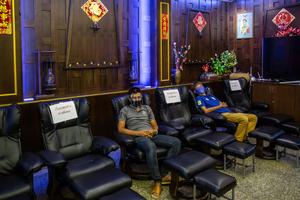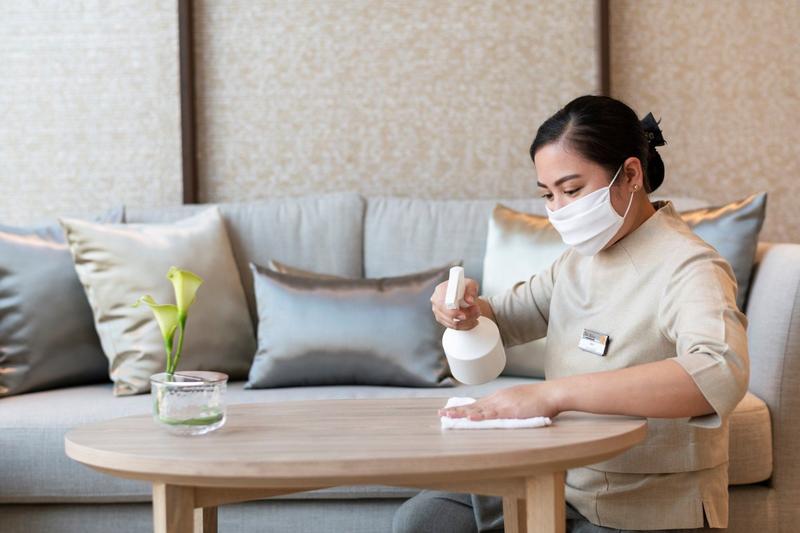 Massage parlor staff sit in socially distanced chairs on their first day of reopening in Bangkok on June 1. (PHOTO / BLOOMBERG)
Massage parlor staff sit in socially distanced chairs on their first day of reopening in Bangkok on June 1. (PHOTO / BLOOMBERG)
Walk into a massage parlor in Thailand and a familiar clasped-hands “wai” greeting will welcome you as a hint of jasmine lingers in the air. Less appealing is the smell of disinfectant and the squeaky sound of latex gloves.
Thai traditional massage is being forced to reinvent itself in the COVID-19 era, in which the human touch has barriers and masks hide the faces of therapists in a country known as the Land of Smiles. That has implications for both its appeal to customers, and its role as employer of last resort when other industries falter in Southeast Asia’s second-biggest economy.
“This isn’t like any crisis we’ve ever seen,” said Wiboon Utsahajit, president of Siam Wellness Group Pcl, which owns about 70 massage shops and spas across Thailand.
READ MORE: Thailand to tout 'trusted' tourism in coronavirus era
“We’ve had to change the way we operate. We’ve installed ultraviolet disinfection equipment in every room, and loaded up on health and cleaning supplies. The costs are higher and customers far fewer.”
According to the Global Wellness Institute, about 530,000 Thais are directly employed in the sector. Those totals equate to 1.4 percent of Thailand’s workforce and 2.6 percent of annual GDP
The survival of this industry matters in Thailand, where wellness tourism generated expenditures of US$12 billion in 2017, more than the combined amounts in Indonesia and Malaysia, according a report by the Global Wellness Institute.
About 530,000 Thais are directly employed in the sector, according to the Miami-based group. Those totals equate to 1.4 percent of Thailand’s workforce and 2.6 percent of annual GDP.
Massage, spa therapy and medical treatments are integral to the wellness-tourism industry, with Thailand’s 2,800 luxury spas alone accounting for US$1.3 billion. Nationwide, the Ministry of Public Health estimates there are about 10,000 massage outlets.
“Massage is a very labor-intensive service, with a skill-set for masseuses that is difficult to transfer to another job,” said Somprawin Manprasert, chief economist at Bank of Ayudhya Pcl. “The competition was already quite high because of so many shops across the country, so it will be challenging for many to survive.”
The Thai government turned to massage during the Asian financial crisis in the late 1990s by expanding vocational training to provide jobless people, regardless of education level, with an employable skill. Siam Wellness’s first outlet came out of this push in 1998.
Massage was also crucial amid the Great Recession a decade later, when Thailand stepped up campaigns to promote luxury spas, medical tourism and wellness a “national export business.”
That push helped Siam Wellness turn into an exchange-listed company with US$44 million of revenue last year, with Greater China accounting for about 55 percent of clients. Now, Wiboon said he plans more outlets in China because of a drop in Thai tourism.
ALSO READ: HKSAR welcomes Thailand's relaxed travel controls
Massage shops were allowed to reopen last month under revised hygiene and social-distancing guidelines after Thailand’s lockdown curbed coronavirus transmission. But many locals are wary and the country’s borders were just opened on July 1 to selective categories of foreign tourists.
 An employee cleans a table at a Siam Wellness spa facility in Bangkok. (PHOTO / BLOOMBERG)
An employee cleans a table at a Siam Wellness spa facility in Bangkok. (PHOTO / BLOOMBERG)
“Most of our masseuses went back to their hometowns after we were ordered shut,” said Natthawipa Sangkakit, whose family runs Phikul Massage and Spa in suburban Bangkok. “All staff are welcome back, but with fewer customers, some may prefer to stay on their farms or try other jobs.”
‘FEWER CUSTOMERS’
To make things worse, Thailand plans to turn away from mass tourism and focus on wooing rich tourists for luxury travel in a post-pandemic world. That won’t help save many jobs in the massage industry.
“Travel restrictions will limit the number of foreigners, while the domestic market will be squeezed by reduced incomes and more conservative spending,” according to Somprawin.
The vast majority of massage parlors in Thailand are modest street-side shops, where fees can range from US$3 to US$10 per hour – and where many of the clients are locals. Revenue is typically split between store owner and therapist, with the latter often paying for oils and supplies – which now include masks.
From this category of shop, more than 140,000 therapists applied for unemployment assistance under the “informal worker” label, according to the government. That tally excludes those who applied under a different job category for privacy reasons, foreign masseuses and the aforementioned salaried staff at luxury spas in hotels and resorts.
Although massage shops have been given the green light to reopen provided they keep least 1.5 meters of space between customers and use separate rooms for some treatments, many remain locked amid the health and tourism obstacles that didn’t exist in previous recessions.
Some foreign visitors will be coming soon under “travel-bubble agreements” Thailand is setting with other countries and territories. But it’s unclear how wary tourists will be of a traditional therapy that UNESCO recognized as a “heritage of humanity” in December 2019, just as the COVID-era was about to start.
“Massage is supposed to be good for health,” said Gao Ze Hui, a human-resources specialist in Beijing who visited several spa and clinics during her two trips to Thailand. “Now we have to be careful about even this.”


